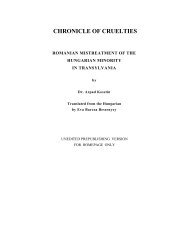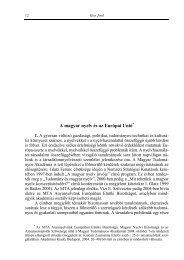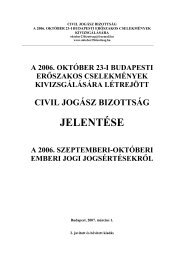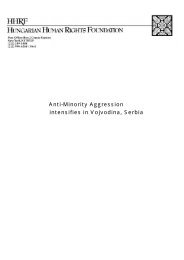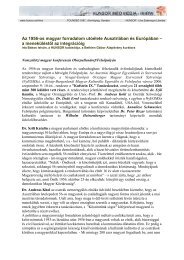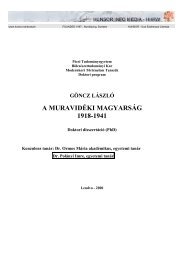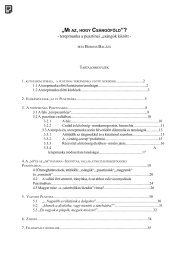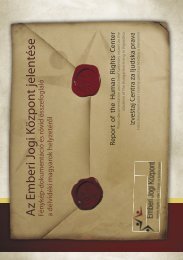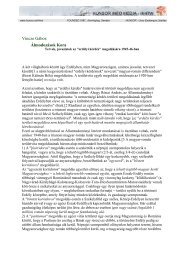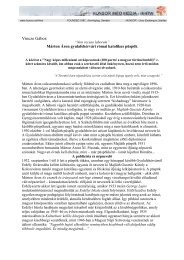Before and during World War II, the composition of the village was approximately thefollowing: O- and Uj-Szivac was one at that time, but 95% of the inhabitants in Uj-Szivac wereGerman, and O-Szivac was mixed. The entire population came to 14,000 among them 8,000-8,500 Germans, 1,200-1,300 Hungarians, and about 4,800 Serbs.When the Hungarian troops withdrew from the village on the 12th and 13th of October,1944, the "communist" commando was formed at once, and they began arresting people (men)on the 15th. Two armed so-called "partisans" carried off my father and me on the 17th. I was ledto a many-storied barn in O-Szivac, where they had already arrested 40-50 local Hungarians andsome Germans. My father was driven to Uj-Szivac, where there were only 10-12 men at thevillage hall, since the partisans did not take any more people there.64Where I was, additional people were brought in. A couple of us were let free, but on the 1st ofNovember, at nine in the morning a group of strangers, called "partisans", burst into the house.They told us they were from Csurog, and that they would shoot, but they just beat us. Most ofthem struck us with rifle butts, in the head, in the shoulder, up and down. I lost consciousnessbecause of the blows, and recovered my senses in the afternoon, but I was unable to move eventhen. The barn (magazine) was at the end of the garden of the Serb school. The Serb teacherrushed to my mother and told her that I was dead. My mother was running to and fro, and triedeverything to get me out of there. At last, with much difficulty, the doctor came to see me. Ireceived an injection from the village doctor, at least I was told so, and regained myconsciousness at about five. But I still was not able to move. At six an official came with thedoctor and with another injection. They put me on a stretcher, and handed me over in the streetto two youngsters. They carried me home, but my mother was not allowed to see me. I could gethome only this way, with a fracture of a rib, unable to see, to hear, or feel anything. By the nextmorning the ten people in the barn in Uj-Szivac had all disappeared. On November 2, we learntthat they had all been executed on that night. My father was among them.Two months later we found out that my cousin had escaped from the Serb cemetery,where all the others were massacred.At the end of December, I was driven to a private infirmary in Hodsag, now Odzaci. Iwas treated so efficiently that in two or three months I could get about again. I stayed in Hodsagtill 1955, when we moved to Szabadka, I still live here. I don't own a thing at home, in O-Szivac,they confiscated all I had. My mother was interned in a camp (lager) without a proper judicialprocess, and released after half a year. She was allowed to live in our house until her death, that'sall they permitted her. Later on she moved in with us in Szabadka.It was only the two of us who escaped from the barn, where 73 men were locked up. Mycousin still lives in Moravica.Dear Mr. Cseres, if you make use of anything written down here please do not mentionmy name, and burn the letter. I would like present-day generations to be aware of what happenedto innocent people who were not even interrogated or sentenced. All that took place then is stillconsidered taboo by the authorities.The roll of the executed victims,
65Ferencz Alfoldi, Lajos Bacso (innkeeper), Janos Baka, Janos Balogh (wool spinner), IstvanBocskovics, Jozsef Bodis, Lajos Bodis, Istvan Breznyak, Jozsef Breznyak, Andras Buza, PeterCzifra, Andras Czifra (lumberman), an unknown male from Csurog, Janos David, JanosDaruhalmi (tanner), Mihaly Domjan, Istvan Dragity (tradesman), Istvan Drobnyik, Janos Farkas,Janos Farkas, Lajos Farkas, Pal Farkas, Istvan Farkas (bricklayer), Jozsef Horvath, AndrasHorvath, Antal Juhasz, Istvan Klebecsko, Andras Lavro, Mihaly Mandity, Janos Mezei(cartwright), Mihaly Merkel, Mihaly Merkel, Jeno Mero, Ferencz Molnar, Antal Mudri, JozsefNagy, Jozsef Nagy Jr., Ferencz Nagy, Imre Nagy, Jozsef Papp (corn buyer), Mihaly Pavlik,Sandor Racz (Chubby, musician), Istvan Racz (musician), Peter Rigo, Peter Siflis, Istvan Siflis,Karoly Skorutyak (tailor), Antal Skorutyak (owner of a small dairy), Adam Strikovics (joiner),Imre Szalai, Janos Szalai, Istvan Szabo Peter Szobek, Istvan Toth, Mihaly Tokodi, MihalyTokodi Jr., Peter Turi, Peter Uglik, Janos Varosi (deputy clerk), Istvan Zseller - all Hungarians.An unknown man from Cservenka, Jakab Burger, Johann Gubola, Anton Hunsinger,Anton Modritsch (tradesman), Ferdinand Stieb, Anton Teehr, Heinrich Winterstein - they werethe German victims.Pero Czigany, a Serb horse-dealer.The people in Szivac were, and still are, so frightened that they did not dare to celebratea mass for their dead, or to bring some flowers to the mass grave.No one knows for what capricious reason the killers had by forcing the men dig the largecommon grave in the shape of a "M" (for abbreviated Magyar in Hungarian), in an areabetween the Catholic (Hungarian) and the Serb cemeteries.In the large village barn the murderers treated their victims in an oddly ambiguous way.Beside torturing and beating people severely, they allowed a doctor to go and see a young boywho was supposed to be dead. They are said to have let the captured teamsters go home for oneor two days to provide for their horses, though these men were looked after strictly, and wereordered to return.Those who were willing to join the Petofi Brigade and fight against the "fascists" werereleased and directed to the organization center, Topolya. On the other hand, the partisans cut offall fingers of Jeno Mero, the veterinarian's son, with an axe, just because he did not want to jointhem.Sandor Simo, the ranger, did not accept either alternative, and66ran away at the right moment, unarmed, squeezing out the eyes of his armed partisan guard.Our correspondent's cousin reports on his daring escape as follows,"Stripped to the skin, wired together in pairs (I was tied with my father), we were led tothe cemetery, and ordered to stand with our backs to the graves, so that they did not have tobother to put our corpses there. It was pitch-dark, only the barrels of machine guns told us thatbehind each barrel a partisan was standing ready to kill. I whispered to my father, "I will undothe wire and we can go!" My father nodded affirmatively, but he surely did not believe that hecould be as youthfully brisk as I was. Having my wrists set free, I knew the partisan officer
- Page 3 and 4: Library of Congress Catalogue Card
- Page 5 and 6: Mutilation of the hands or feet wit
- Page 7 and 8: they wanted to belong. On the annex
- Page 9 and 10: individuals, then shooting them by
- Page 11 and 12: the Russians and under their protec
- Page 13 and 14: 22PEOPLE OF BEZDAN1.On a May aftern
- Page 16 and 17: 26that those people all fell victim
- Page 18 and 19: ack a 13 year-old boy to the soccer
- Page 20 and 21: Russian officers cursed and told th
- Page 22 and 23: Jani was set free for he had been a
- Page 24 and 25: There were some people who, in spit
- Page 26 and 27: March 12, 1945. The relatives of th
- Page 28 and 29: Ferenc Csapo, 33 Mihaly Miovacs, 18
- Page 30 and 31: Having heard about the advance of t
- Page 32 and 33: "On November 3, I got up at five in
- Page 34 and 35: The vicar would come every night. H
- Page 36 and 37: hand. Raising it to his mouth, he d
- Page 38 and 39: "24th October, 1944. Yesterday was
- Page 40 and 41: "I have only one chance to be sacri
- Page 42 and 43: The data, which shows that on the s
- Page 44 and 45: all the captured Serbs, as neither
- Page 48 and 49: would order fire in an instant. Wit
- Page 50 and 51: Our house looked out over the main
- Page 52 and 53: He had just arrived home after thre
- Page 54 and 55: 28. Jozsef Pasztor, 34 56. Albert G
- Page 56 and 57: The OZNA officer, who exhumed a mas
- Page 58 and 59: 7917 year old Karoly and 8 year old
- Page 60 and 61: 82FROM SZENTFULOP TO THE GAKOVA CAM
- Page 62 and 63: My mother died on January 4, 1946.
- Page 64 and 65: Jozsi, the leader of our committee
- Page 66 and 67: his own grave, then machine gunned
- Page 68 and 69: driving a wheelbarrow on the sidewa
- Page 70 and 71: "Now that's exactly what we needed
- Page 72 and 73: 15 Istvan Polyakovics, Zenta, 18861
- Page 74 and 75: idge was built (from several rows o
- Page 76 and 77: There is a common opinion among the
- Page 78 and 79: The Catholics of the village were o
- Page 80 and 81: and their supporters. On one occasi
- Page 82 and 83: "My younger brother, Bandi, was tak
- Page 84 and 85: two young instructors staying in he
- Page 86 and 87: In Tunderes (Vilova) there was no o
- Page 88 and 89: weeks spent starving, laying on str
- Page 90 and 91: 121PACSERAt Pacser sixteen Serbians
- Page 92 and 93: piece of land, there are three rows
- Page 94 and 95: "I understood that through the OZNA
- Page 96 and 97:
took the priest under their protect
- Page 98 and 99:
"We set off from Hadikliget on Octo
- Page 100 and 101:
everyone to the front! The Party us
- Page 102 and 103:
137REPORT OF LOSSESIn addition to o
- Page 104 and 105:
141Source: Zlocini okupatora u Vojv
- Page 106 and 107:
well as in words, that there had be
- Page 108 and 109:
The American military forces delive
- Page 110 and 111:
culpability or participation are th
- Page 112 and 113:
The accused did not make use of his
- Page 114 and 115:
the spirit of revenge among the Hun
- Page 116 and 117:
considered all the claims of Hungar
- Page 118 and 119:
The People's Court of Budapest just
- Page 120 and 121:
From then on all hell breaks loose.
- Page 122 and 123:
Recommended readingeRudolf Kiszlion



